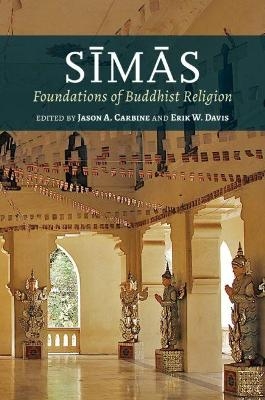
Simas
Foundations of Buddhist Religion
Seiten
2022
University of Hawai'i Press (Verlag)
978-0-8248-8885-5 (ISBN)
University of Hawai'i Press (Verlag)
978-0-8248-8885-5 (ISBN)
Human-fashioned boundaries transform spaces by introducing dualisms, bifurcations, creative symbioses, contradictions, and notions of inclusion and exclusion. The Buddhist boundaries considered in this book come in various shapes and sizes and can be established on land or in bodies of water.
Human-fashioned boundaries transform spaces by introducing dualisms, bifurcations, creative symbioses, contradictions, and notions of inclusion and exclusion. The Buddhist boundaries considered in this book, sīmās—a term found in South and Southeast Asian languages and later translated into East Asian languages—come in various shapes and sizes and can be established on land or in bodies of water. Sometimes, the word sīmā refers not only to a ceremonial boundary, but the space enclosed by the boundary, or even the markers (when they are used) that denote the boundary.
Sīmās were established early on as places where core legal acts (kamma), including ordination, of the monastic community (sangha) took place according to their disciplinary codes. Sīmās continue to be deployed in the creation of monastic lineages and to function in diverse ways for monastics and non-monastics alike. As foundations of Buddhist religion, sīmās are used to sustain, revitalize, or reform Buddhist practices, notions of identity, and conceptualizations of time and history. In the last few decades, scholarly awareness of and expertise on sīmās has developed to a point where a volume like this one, which examines sīmās across numerous cultural contexts and scholarly fields of inquiry, is both possible and needed. Sīmā traditions expressed in the Theravāda cultures of Myanmar, Thailand, Laos, Cambodia, Bangladesh, and Sri Lanka constitute the dominant focus of the work; a chapter on East Asia raises questions of historical transmission beyond these areas. Throughout contributors engage texts; history; archaeology; politics; art; ecology; economics; epigraphy; legal categories; mythic narratives; understandings of the cosmos; and conceptualizations of compassion, authority, and violence.
Examining sīmās through multiple perspectives allows us to look at them in their contextual specificity, in a way that allows for discernment of variation as well as consistency. Sīmā spaces can be both simple and extremely intricate, and this book helps show why and how that is the case.
Human-fashioned boundaries transform spaces by introducing dualisms, bifurcations, creative symbioses, contradictions, and notions of inclusion and exclusion. The Buddhist boundaries considered in this book, sīmās—a term found in South and Southeast Asian languages and later translated into East Asian languages—come in various shapes and sizes and can be established on land or in bodies of water. Sometimes, the word sīmā refers not only to a ceremonial boundary, but the space enclosed by the boundary, or even the markers (when they are used) that denote the boundary.
Sīmās were established early on as places where core legal acts (kamma), including ordination, of the monastic community (sangha) took place according to their disciplinary codes. Sīmās continue to be deployed in the creation of monastic lineages and to function in diverse ways for monastics and non-monastics alike. As foundations of Buddhist religion, sīmās are used to sustain, revitalize, or reform Buddhist practices, notions of identity, and conceptualizations of time and history. In the last few decades, scholarly awareness of and expertise on sīmās has developed to a point where a volume like this one, which examines sīmās across numerous cultural contexts and scholarly fields of inquiry, is both possible and needed. Sīmā traditions expressed in the Theravāda cultures of Myanmar, Thailand, Laos, Cambodia, Bangladesh, and Sri Lanka constitute the dominant focus of the work; a chapter on East Asia raises questions of historical transmission beyond these areas. Throughout contributors engage texts; history; archaeology; politics; art; ecology; economics; epigraphy; legal categories; mythic narratives; understandings of the cosmos; and conceptualizations of compassion, authority, and violence.
Examining sīmās through multiple perspectives allows us to look at them in their contextual specificity, in a way that allows for discernment of variation as well as consistency. Sīmā spaces can be both simple and extremely intricate, and this book helps show why and how that is the case.
Jason A. Carbine is associate professor and C. Milo Connick Chair of Religious Studies at Whittier College in Whittier, California. Erik W. Davis is associate professor of religious studies at Macalester College, in Saint Paul, Minnesota.
| Erscheinungsdatum | 31.01.2022 |
|---|---|
| Zusatzinfo | 19 b&w illustrations |
| Verlagsort | Honolulu, HI |
| Sprache | englisch |
| Maße | 152 x 229 mm |
| Gewicht | 771 g |
| Themenwelt | Geisteswissenschaften ► Geschichte ► Regional- / Ländergeschichte |
| Geisteswissenschaften ► Religion / Theologie ► Buddhismus | |
| Geisteswissenschaften ► Religion / Theologie ► Christentum | |
| ISBN-10 | 0-8248-8885-5 / 0824888855 |
| ISBN-13 | 978-0-8248-8885-5 / 9780824888855 |
| Zustand | Neuware |
| Haben Sie eine Frage zum Produkt? |
Mehr entdecken
aus dem Bereich
aus dem Bereich
Erinnerungen
Buch | Softcover (2024)
Pantheon (Verlag)
16,00 €


